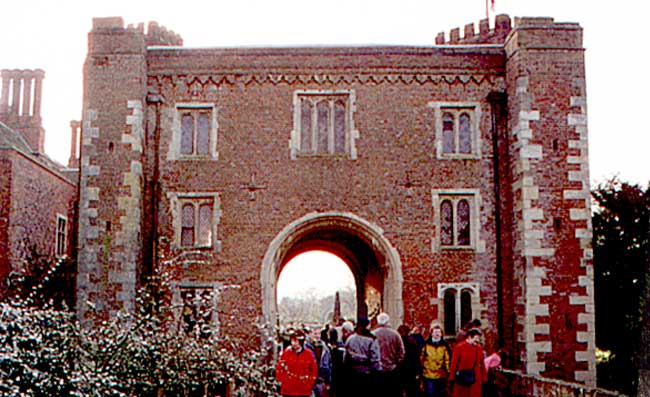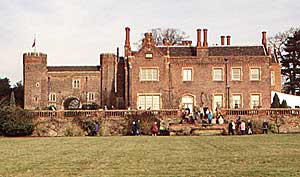Hodsock Priory.

The 16th century brick gatehouse to Hodsock Priory.
HODSOCK PRIORY is in the civil parish of Hodsock and the population in 1931 was 4,395, but the great majority of the inhabitants live at Langold, the new mining village on the west side of the parish. The population before the opening of the new pit was only about 200. There is no record of any Priory here, and the reason for naming this house Hodsock Priory is, therefore, unknown.
According to Domesday Book, Ulsi was the pre-Conquest owner of Hodsock. Next came Torald de Lisoriis, who held his land from de Bush, and had two ploughs and three sokemen here. Then followed the Cressys, Cliftons, and Mellishs. Hodsock has, therefore, only had four families as owners since 1066.

The south-west facing part of the house dates from the early 19th century.
Not much is known about Torald, save that he was thought worthy to witness the foundation deed of 1088, by which Roger de Bush founded Blyth Priory, nor is the date known when the estate passed from Torald to the Cressy family, the second owners. The two families were, however, related by marriage. The Cressys were great landed proprietors by the time of Henry II (1154-1189), for, in addition to holding Hodsock, they held land elsewhere in the county, and in some of the latter cases, also, they appear to have succeeded Torald. The family ruled at Hodsock for nine generations. William Cressy rebelled against King John, who was there for a few days in December 1215 and January 1216. Edward I was also there in 1280, and again in 1291. In 1297 a William Cressy was called out for military service in Scotland. The last male of the line was Sir Hugh Cressy, but for some time before his death in 1408, the family had mainly resided on their Lincolnshire estate.
The Cliftons acquired the estate by the marriage of Sir John Clifton (died 1403) to Katherine Cressy, sister of Hugh aforesaid, and they lived and built here, as well as at Clifton, their principal seat. Their tenure endured for about 350 years—or thirteen generations—till 1765.
In the year 1765, Sir Gervase Clifton sold this estate to the Mellish family, then seated at Blyth. The Mellishs moved to Hodsock in 1806. Lieutenant-Colonel Henry Mellish, C.B., the last male of the line, died there in 1927, though his two unmarried sisters continued to live in the priory for the few years they survived him. The Mellishs appear to have owed their good fortune to an ancestor in London who was engaged in the cloth trade, and bought Blyth from the Saundersons in 1635. When the civil war broke out the estate was sublet to a royalist colonel named Hayley, who managed to secure its sequestration in his own favour. Mellish, however, also supported the king and soon recovered it. The first Mellish did not reside at Blyth, but on his death in 1677, his eldest son, Edward, came to live there. This Edward’s tomb is in Blyth church. He was for some years a merchant in Oporto, but returned to England seven years before his father died. Edward pulled down the Blyth Abbey mansion, as it was called, and by 1684 had replaced it by Blyth Hall, the shell of which is still standing. The Mellish family lived in the hall until 1806, when Colonel Henry Francis Mellish sold Blyth to Joshua Walker, and a good deal of land to the Foljambes a year later. The colonel was a great figure in racing and gambling circles in the early 19th century. After a period of service in the Peninsula, he returned home and settled down at Hodsock to the quiet life of a country gentleman, useful and popular, though greatly impoverished. He had, at one time, thirty-eight racehorses in training and others in proportion—up to about one hundred in all. When engaged in losing his money at the gaming table, he would drop as much as f40,000 or £50,000 at a throw. He died at the age of thirty-seven. In many respects the greatest, and in all respects the most useful, member of the family was the last—namely, Henry Mellish, C.B., who died as already stated, in 1927. The value and importance of his work for his fellow-citizens in this county can hardly be overstated He was also well-known and valued in circles outside those of local government. A memorial plaque to his memory was placed on the west wall of the Grand Jury Room in the Shire Hall, where for many years he was foremost in work and wisdom.
The first moated manor house of Hodsock dated from 1250-3. An extent of the manor, dating from 1324, describes the site as follows:
"[there] is there a certain Manor, surrounded on all sides with a moat, in which [there] are: one hall (aula), three chambers (camere), a pantry, a buttery, a kitchen, a bake-house, a granary, two barns, one chapel, two stables, one chamber above the bridge with portcullis and drawbridge, one malt-kiln, [and] two fish-ponds ..."
Source: J Z Titow, English rural society, 1200-1350, 1960, p151.
It is difficult to reconstruct in imagination the old hall of which the gateway formed part. There is no evidence of a pre-Conquest residence there. The Cressys must have had a mansion at Hodsock, for we know that two kings stayed there. The moat belongs to their time. The present gateway is said to date from the times of the Cliftons, and was probably part of a mansion built very early in the 16th century. When Dugdale recorded his Visitation in 1662, he mentioned the name of Robert Clifton as appearing on a scroll, along with some shields, over a bay-window of the hall. This would seem to suggest that the hall, if not the gateway, was built very early in the 16th century. The Cliftons left about 1653. Some of them were born there and baptized at Blyth. The hall gradually fell into ruins and was later used as a farmhouse. By 1829 the Mellish family had built the present mansion. There is nothing to indicate whether the house, of which the gateway formed part, was a two-storey or a three-storey building, and we should only be guessing if we attempt to describe a building of which so little is left. There are good grounds for assuming that there would be a quadrangular courtyard, of which the gateway and the small sections of wall on either side of it would form one of the three sides, the opposite side possibly being formed by the hall itself. But nothing is known of the size of the building. We can, however, see that in the main, the bricks are laid in alternate rows of ends and sides, in the manner of the English Bond, as was the case till Queen Anne’s time.
